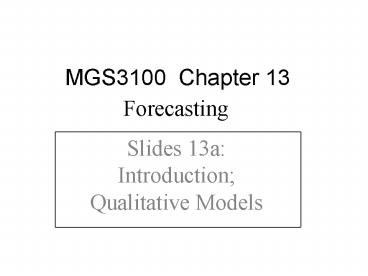Slides 13a: Introduction; Qualitative Models - PowerPoint PPT Presentation
1 / 12
Title:
Slides 13a: Introduction; Qualitative Models
Description:
For example, during the high-interest-rate period of 1980 and ... Requires an experienced stable work force that knows the customer base. Not good at retail! ... – PowerPoint PPT presentation
Number of Views:25
Avg rating:3.0/5.0
Title: Slides 13a: Introduction; Qualitative Models
1
Slides 13a Introduction Qualitative Models
MGS3100 Chapter 13
Forecasting
2
What is a Forecast?
- A guess about what is going to happen in the
future - An integral part of almost all business
enterprises - Logical and rational, but still a guess!
- Objective is to minimize error (as you will
always be wrong!) - Could be a complicated or simple process
3
What is a Forecast? (contd)
- Good forecasts can lead to
- Reduced inventory costs
- Lower overall personnel costs
- Increased customer satisfaction
- The forecasting process can be based on
- Educated guess
- Expert opinions
- Past history
4
Introduction to Forecasting Examples
- Manufacturing firms forecast demand for their
product, to schedule manpower and raw material
allocation - Service organizations forecast customer arrival
patterns to maintain adequate customer service - Security analysts forecast revenues, profits, and
debt ratios, to make investment recommendations - Firms consider economic forecasts of indicators
(housing starts, changes in gross national
profit) before deciding on capital investments.
5
Model Differences
- Qualitative opinion-based incorporates
judgmental and subjective factors into forecast - Quantitative number-based most frequently used
- Time-Series attempts to predict the future by
using historical data over time - Causal incorporates factors that may influence
the quantity being forecasted into the model
6
Forecasting Models
7
Qualitative Models Using Expert Judgment
Many important forecasts are not based on formal
models. For example, during the
high-interest-rate period of 1980 and 1981, the
most influential forecasters of interest rates
were Henry Kaufman of Salomon Brothers and Albert
Wojnilower of First Boston. These gentlemen
combined relevant factors such as the money
supply and unemployment, as well as results from
quantitative models, in their own intuitive way
to produce forecasts that had widespread
credibility and impact on the financial
community. If you needed a long-term forecast
for the personal computer market, what approach
would you take?
8
The Delphi Method
The Delphi Method confronts the problem of
obtaining a combined forecast from a group of
experts. The consensus panel approach is to
bring the experts together in a room and let them
discuss an event until a consensus emerges.
However, due to group dynamics, one person with a
strong personality can have an enormous effect on
the forecast. The Delphi Method was developed
by the Rand Corporation to retain the strength of
a joint forecast, while removing the effects of
group dynamics.
9
The Delphi Method (contd)
- Iterative group process allows experts to make
forecasts without meeting face-to-face - Participants are typically 5-10 experts who make
the forecast - Staff personnel assist by preparing,
distributing, collecting, and summarizing a
series of questionnaires and survey results - After three or four passes through this process,
a consensus forecast typically emerges.
10
Grassroots Forecasting
The Grassroots technique is based on the
concept of asking those who are close to the
eventual consumer, such as salespeople, about
what they are going to sell next period, and
added the forecasts to predict total
demand. Requires an experienced stable work
force that knows the customer base. Not good at
retail! Can be expensive. Takes sales people
away from sales effort. Results can be
biased. In more sophisticated systems, forecasts
may be adjusted on the basis of the historical
correlation between the salespersons forecasts
and the actual sales.
11
Consulting Customers (Market Research)
Market research is a large and important topic
which includes a variety of techniques, from
consumer panels through consumer surveys and on
to test marketing. The goal of market research
is to make predictions about the size/structure
of the market for specific goods and/or services.
These predictions (forecasts) are usually
based on small samples and are qualitative in the
sense that the original data typically consist of
subjective evaluations of consumers. Market
research is an important activity in most
consumer product firms. It also plays an
increasingly important role in the political and
electoral process.
12
Jury of Executive Opinion
- Opinions of a small group of high level
managers - Often in combination with statistical models
- Result is a group estimate































